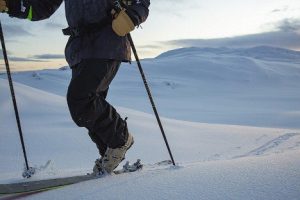
Ski pants are perhaps the most underrated piece of equipment you'll wear on the slopes. They're not just about making you look cool in photos (although that's a thing too), but choosing the right ski pants will keep you warm, dry, and comfortable every day on the mountain.
Waterproof
Your ski pants need to be waterproof to protect you from unexpected weather, snow flying down the mountain, or worst case scenario, a fall. Some trousers are labeled with the degree of waterproofing, usually from 5,000mm to 20,000mm (5K – 20K); The higher the number, the more waterproof the pants are. However, keep in mind that some ski pants are made from special materials, such as GORE-TEX or The North Face's DryVent, which are waterproof but are not rated under this system.
Insulation

The most versatile type of ski pants are non-insulated pants that are lined for added warmth and comfort.You can choose insulated pants with synthetic insulation, but if you get cold easily, we would recommend boxer pants and thermal leggings. Layers are always the best way to keep warm. For added warmth and protection from the elements, consider high-waist or bib pants. Cross-country skiers do much more aerobic exercise than piste skiers, so ski pants designed for athletes are usually lightweight and unlined.
Seams
Taping prevents moisture from seeping through the seams of ski pants. There are two common types of seam taping:
- Critical sizing means that only those seams that are normally exposed to moisture are taped. This is the least waterproof option, but if you don't expect wet weather, critical sizing will be enough to keep you dry.
- Fully taped ski pants have every seam taped, both inside and out, for maximum waterproof performance even in extreme weather conditions.
If you like the retro racing chic of fitted pants, look for pants with a 4-way stretch to allow complete freedom of movement and a great fit. Looser pants always allow for freedom of movement and have a more relaxed, urban style.
For an even more customized fit, snow pants can be purchased in different leg lengths to suit all skiers. Users choose Roxy and Schoffel for long legs, and Henri Duvillard and Eider for shorter ones.
Snow gaiters
Snow gaiters are a waterproof seal found in most ski pants that are designed to fit around your ski boots to keep snow and water out.Gaiters may have hooks that attach to ski boot buckles for added protection, and they are all adjustable to ensure the correct fit.
Reinforced cuffs
Unlike snowboard pants, the cuffs of ski pants are usually reinforced in areas where the inner edge of the skis would cause fraying of the pant fabric. Extra durable fabric is used to reinforce the cuffs and protect the trousers from contact with ski edges and crampons.
Some ski pants have vents on the inner thighs to circulate air and regulate temperature. The material and length of the vents depend on what the pants are intended for; Technical backcountry ski pants often feature full-length side zippers for maximum ventilation.
Pockets
Different types of ski pants have different numbers and styles of pockets, from baggy mini pouches to almost decorative pockets large enough for just your ski pass. When choosing ski pants, consider what you'll need to take with you to the mountain. It's always better to have everything you need than to end your day early due to lack of pockets.


 0
0





